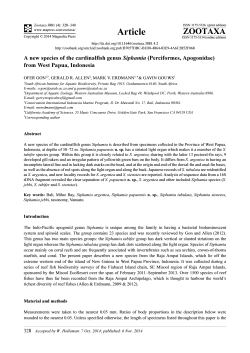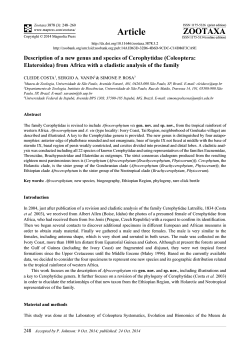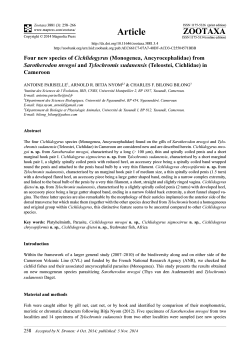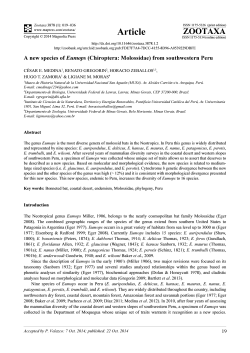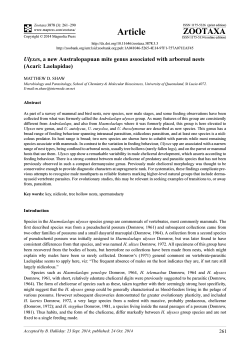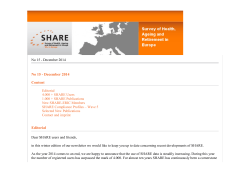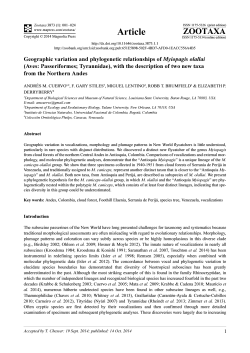
Preview - Magnolia Press
Zootaxa 3941 (3): 401–413 www.mapress.com /zootaxa / Copyright © 2015 Magnolia Press Article ISSN 1175-5326 (print edition) ZOOTAXA ISSN 1175-5334 (online edition) http://dx.doi.org/10.11646/zootaxa.3941.3.6 http://zoobank.org/urn:lsid:zoobank.org:pub:F85B980D-EC2F-4F68-A377-4307B85A59E8 A cultivable acoel species from the Mediterranean, Aphanostoma pisae sp. nov. (Acoela, Acoelomorpha) THOMAS ZAUCHNER, WILLI SALVENMOSER & BERNHARD EGGER1 Research unit Evolutionary Developmental Biology, Institute of Zoology, University of Innsbruck, Technikerstr. 25, 6020 Innsbruck, Austria. E-mail: thomas.zauchner@gmx.at, willi.salvenmoser@uibk.ac.at, bernhard.egger@uibk.ac.at 1 Corresponding author. E-mail: bernhard.egger@uibk.ac.at Abstract Aphanostoma pisae sp. nov. is an interstitial acoel found at the coast of the Liguric Sea in Pisa (Tuscany, Italy). It belongs to the large family Isodiametridae, characterised by a male copulatory organ with a cylindrical shape and non-anastomising longitudinal muscle fibers. It is the first recognised species of Aphanostoma in the Mediterranean and it can occur in great abundance at its type locality (several hundred specimens in a spoonful of sand). A. pisae has been cultured in the laboratory for several years with diatoms for food. The embryonic development lasts for just under two days at 20 °C. We provide a description of the new species using live observations, light and electron microscopy of sagittal sections and stainings of the filamentous actin and the serotonergic nervous system, and we discuss and update the genus diagnoses of the genera Aphanostoma and Praeconvoluta. Key words: Xenacoelomorpha, acoel flatworm, taxonomy, phalloidin, antibody stainings Introduction Acoels are predominantly marine worms with a contested phylogenetic position. For more than a century, acoels were considered members of the Platyhelminthes based on many morphological similarities (Ehlers, 1985), but a great number of molecular analyses now place them either as sister group of the Bilateria (Ruiz-Trillo et al., 1999, Egger et al., 2009) or, most recently, as deuterostomes (Philippe et al., 2011). Identification of acoels requires careful observation and in many cases sagittal sections of the genital organs of mature animals are required for identification (Westblad, 1948). Staining of the musculature (F-actin) can provide an additional level of detail for characterising these organs and the body wall musculature (Hooge, 2001; Hooge & Tyler, 2005). While many Scandinavian and Northern German acoel species have been described, the Mediterranean (and even more so most other parts of the world) are still comparatively poorly covered (Nilsson et al., 2011). This trend is reflected in the absence of recognised species of the genus Aphanostoma Ørsted, 1845 in the Mediterranean. With this work, we provide the first description of an Aphanostoma species in the Mediterranean with images of live animals, sagittal sections, and stainings of the musculature and the serotonergic nervous system. We also propose a revision of the closely related genera Aphanostoma and Praeconvoluta Dörjes, 1968. Material and methods Sampling. Sand samples from Marina di Pisa, Italy (43.6761°N 10.2698° E) were taken in May 2005 and May 2011. Animals were extracted from the sand in 7% MgCl2 · 6H2O mixed 1:1 with artficial sea water and then transferred to petri dishes (see below). Cultures. Aphanostoma pisae was cultured in petri dishes with enriched sea water (f/2 medium) and fed ad libitum with the diatom Nitzschia curvilineata in a constant environment at 20°C with a day/night cycle of 12/12 hours. About every two weeks, algae were replaced if necessary. When starting new dishes, about 40 adult worms Accepted by W. Sterrer: 5 Mar. 2015; published: 1 Apr. 2015 Licensed under a Creative Commons Attribution License http://creativecommons.org/licenses/by/3.0 401 Aphanostoma species (see Jondelius et al., 2011; Nilsson et al., 2011). Second, there is hardly any difference in the generic diagnoses of Aphanostoma and Praeconvoluta, other than an elliptical penis sheath in Praeconvoluta, as opposed to a spherical penis sheath in Aphanostoma. Molecular analyses so far suggest both genera should be merged (see Jondelius et al., 2011; Nilsson et al., 2011). To help with this decision, it seems to be worthwhile to make an effort constructing a phylogenetic tree of the Isodiametridae with as many species as possible. Acknowledgements In memoriam Reinhard Rieger, who told his students not to become taxonomists. We are especially grateful to Matthew Hooge for his great help in species determination and reviewing the manuscript and to two anonymous reviewers. We'd like to acknowledge all Pisa excursion participants in 2005 and 2011: Reinhard Rieger, Gunde Rieger, Robert Gschwentner, Johannes Achatz, Christian Gärber, Lukas Schärer, Dita Vizoso, Gregor Schulte, Peter Sandner, Johanna Zaubzer, Lena Egger, Lena Zitzelsberger, Veronika Prantl, Diane Rudulph and Julian Smith III; Johannes Achatz is also acknowledged for contributing valuable taxonomic insights and for helping with the acknowledgements. References Achatz, J.G. & Martinez, P. (2012) The nervous system of Isodiametra pulchra (Acoela) with a discussion on the neuroanatomy of the Xenacoelomorpha and its evolutionary implications. Frontiers in Zoology, 9, 27. http://dx.doi.org/10.1186/1742-9994-9-27 Beklemischev, V.N. (1915) Sur les turbellariés parasites de la côte Mourmanne. I. Acoela. Travaux de la Société impériale des naturalistes de St. Petersbourg, 43 (4), 103–172. Diesing, K.M. (1862) Revision der Turbellarien. Abtheilung: Rhabdocoelen. Sitzungsberichte der MathematischNaturwissenschaftlichen Classe der Kaiserlichen Akademie der Wissenschaften Abtheilung 1, 45, 191–318. Dörjes, J. (1968) Die Acoela (Turbellaria) der deutschen Nordseeküste und ein neues System der Ordnung. Journal of Zoological Systematics and Evolutionary Research, 6, 56–452. http://dx.doi.org/10.1111/j.1439-0469.1968.tb00431.x Dörjes, J. (1972) Faerlea echinocardii sp. n. und Diskussion der Gattungen Avagina Leiper und Faerlea Westblad (Turbellaria Acoela). Zoologica Scripta, 1 (3), 185–189. http://dx.doi.org/10.1111/j.1463-6409.1972.tb00675.x Egger, B. & Ishida, S. (2005) Chromosome fission or duplication in Macrostomum lignano (Macrostomida, Plathelminthes)—remarks on chromosome numbers in "archoophoran turbellarians". Journal of Zoological Systematics and Evolutionary Research, 43 (2), 127–132. http://dx.doi.org/10.1111/j.1439-0469.2005.00300.x Egger, B., Steinke, D., Tarui, H., De Mulder, K., Arendt, D., Borgonie, G., Funayama, N., Gschwentner, R., Hartenstein, V., Hobmayer, B., Hooge, M., Hrouda, M., Ishida, S., Kobayashi, C., Kuales, G., Nishimura, O., Pfister, D., Rieger, R., Salvenmoser, W., Smith III, J., Technau, U., Tyler, S., Agata, K., Salzburger, W. & Ladurner, P. (2009) To be or not to be a flatworm: The acoel controversy. PLoS ONE, 4 (5), e5502. http://dx.doi.org/10.1371/journal.pone.0005502 Ehlers, U. (1985) Das Phylogenetische System der Plathelminthes. Gustav Fischer, Stuttgart & New York, 317 pp. Eisenman, E.A. & Alfert, M. (1982) A new fixation procedure for preserving the ultrastructure of marine invertebrate tissues. Journal of Microscopy, 125, 117–120. http://dx.doi.org/10.1111/j.1365-2818.1982.tb00327.x Faubel, A. (1974) Die Acoela (Turbellaria) eines Sandstrandes der Nordseeinsel Sylt. Mikrofauna des Meeresbodens, 32, 1–58. Faubel, A. (1977) Zwei neue interstitielle Arten der Acoela (Turbellaria) von Norwegen. Zoologica Scripta, 6 (1), 21–25. http://dx.doi.org/10.1111/j.1463-6409.1977.tb00756.x Faubel, A. & Regier, S. (1983) Anatomy and taxonomy of new Acoela (Turbellaria) from the sublittoral of the northern North Sea. Senckenbergiana maritima, 15 (1), 1–17. Hooge, M.D. (2001) Evolution of body-wall musculature in the Platyhelminthes (Acoelomorpha, Catenulida, Rhabditophora). Journal of Morphology, 249 (3), 171–194. http://dx.doi.org/10.1002/jmor.1048 Hooge, M.D. & Rocha, C.E.F. (2006) Acoela (Acoelomorpha) from the northern beaches of the state of São Paulo, Brazil, and a systematic revision of the family Otocelididae. Zootaxa, 1335, 1–50. Hooge, M.D. & Tyler, S. (1999) Body-wall musculature of Praeconvoluta tornuva, n. sp. (Acoela, Platyhelminthes) and the use of muscle patterns in taxonomy. Invertebrate Biology, 118 (1), 8–15. http://dx.doi.org/10.2307/3226907 412 · Zootaxa 3941 (3) © 2015 Magnolia Press ZAUCHNER ET AL. Hooge, M.D. & Tyler, S. (2003) Acoels (Platyhelminthes, Acoela) from the Atlantic coast of North America. Meiofauna Marina, 12, 7–36. Hooge, M.D. & Tyler, S. (2005) New tools for resolving phylogenies: a systematic revision of the Convolutidae (Acoelomorpha, Acoela). Journal of Zoological Systematics and Evolutionary Research, 43 (2), 100–113. http://dx.doi.org/10.1111/j.1439-0469.2005.00301.x Hooge, M.D. & Tyler, S. (2008) Acoela (Acoelomorpha) from Bocas del Toro, Panama. Zootaxa, 1719, 1–40. Jensen, O.S. (1878) Turbellaria ad litora Norvegiae occidentalia. Turbellarier ved Norges Vestkyst. J.W. Eided Bogtrykkeri, Bergen, 97 pp. http://dx.doi.org/10.5962/bhl.title.1932 Jondelius, U., Wallberg, A., Hooge, M. & Raikova, O.I. (2011) How the worm got its pharynx: phylogeny, classification and Bayesian assessment of character evolution in Acoela. Systematic Biology, 60 (6), 845–871. http://dx.doi.org/10.1093/sysbio/syr073 Kozloff, E.N. (1965) New species of the acoel turbellarians from the Pacific coast. Biological Bulletin, 129, 151–166. http://dx.doi.org/10.2307/1539774 Ladurner, P. & Rieger, R.M. (2000) Embryonic muscle development of Convoluta pulchra (Turbellaria: Acoelomorpha, Platyhelminthes). Developmental Biology, 222 (2), 359–375. http://dx.doi.org/10.1006/dbio.2000.9715 Meixner, J. (1938) Turbellaria (Strudelwürmer). In: Grimpe, G. & Wagler, E. (Eds.), Die Tierwelt der Nord- und Ostsee. Vol. 33 (IVb). Akademische Verlagsgesellschaft, Leipzig, pp. 1–146. Mollenhauer, H.H. (1964) Plastic embedding mixtures for use in electron microscopy. Stain Technology, 39 (2), 111–114. Nilsson, K.S., Wallberg, A. & Jondelius, U. (2011) New species of Acoela from the Mediterranean, the Red Sea, and the South Pacific. Zootaxa, 2867, 1–31. Nimeth, K.T., Egger, B., Rieger, R., Salvenmoser, W., Peter, R. & Gschwentner, R. (2007) Regeneration in Macrostomum lignano (Platyhelminthes): cellular dynamics in the neoblast stem cell system. Cell and Tissue Research, 327, 637–646. http://dx.doi.org/10.1007/s00441-006-0299-9 Ørsted, A.S. (1845) Fortegnelse over Dyr, samlede i Christianafjord ved Drøbak. Naturhistorisk Tidsskrift udgivet of Henrik Krøyer, Series 2, 1, 400–427. Pereyaslawzewa, S. (1892) Monographie des turbellaries de la Mer Noire. Schriften der neurussischen naturforschenden Gesellschaft, 17 (3), 1–303. Petrov, A., Hooge, M. & Tyler, S. (2006) Comparative morphology of the bursal nozzles in acoels (Acoela, Acoelomorpha). Journal of Morphology, 267 (5), 634–648. http://dx.doi.org/10.1002/jmor.10428 Philippe, H., Brinkmann, H., Copley, R.R., Moroz, L.L., Nakano, H., Poustka, A., Wallberg, A., Peterson, K.J. & Telford, M.J. (2011) Acoelomorph flatworms are deuterostomes related to Xenoturbella. Nature, 470 (7333), 255–260. http://dx.doi.org/10.1038/nature09676 Reuter, M., Raikova, O.I. & Gustafsson, M.K.S. (2001) Patterns in the nervous and muscle systems in lower flatworms. Belgian Journal of Zoology, Supplement 1 (131), 47–53. Richardson, K.C., Jarret, L. & Finke, E.H. (1960) Embedding in epoxy resins for ultrathin sectioning in electron microscopy. Stain Technology, 35 (6), 313–323. http://dx.doi.org/10.3109/10520296009114754 Romeis, B. (1968) Mikroskopische Technik. R. Oldenbourg Verlag, München, 757 pp. Ruiz-Trillo, I., Riutort, M., Littlewood, D.T., Herniou, E.A. & Baguña, J. (1999) Acoel flatworms: earliest extant bilaterian Metazoans, not members of Platyhelminthes. Science, 283 (5409), 1919–1923. http://dx.doi.org/10.1126/science.283.5409.1919 Salvenmoser, W., Egger, B., Achatz, J.G., Ladurner, P. & Hess, M.W. (2010) Electron microscopy of flatworms: standard and cryo-preparation methods. Methods in Cell Biology, 96, 307–330. http://dx.doi.org/10.1016/S0091-679X(10)96014-7 Smith, J.P.S. & Bush, L. (1991) Convoluta pulchra, n. sp., (Turbellaria: Acoela) from the east coast of North America. Transactions of the American Microscopical Society, 110, 12–26. Spurr, A.R. (1969) A low-viscosity epoxy resin embedding medium for electron microscopy. Journal of Ultrastructure Research, 26 (1–2), 31–43. http://dx.doi.org/10.1016/s0022-5320(69)90033-1 Steinböck, O. (1933) Die Turbellarienfauna der Umgebung von Rovigno. Thalassia, 1, 1–33. Tyler, S. & Rieger, R.M. (1999) Functional morphology of musculature in the acoelomate worm, Convoluta pulchra (Plathelminthes). Zoomorphology, 119 (3), 127–141. http://dx.doi.org/10.1007/s004350050087 Tyler, S., Schilling, S., Hooge, M. & Bush, L.F. (2006–2013) Turbellarian taxonomic database. Version 1.7. Available from: http://turbellaria.umaine.edu (accessed 1 November 2014). Westblad, E. (1945) Studien über skandinavische Turbellaria Acoela. III. Arkiv för Zoologi, 36A (5), 1–56. Westblad, E. (1948) Studien über skandinavische Turbellaria Acoela. V. Arkiv för Zoologi, 41A (7), 1–82. A CULTIVABLE ACOEL SPECIES APHANOSTOMA Zootaxa 3941 (3) © 2015 Magnolia Press · 413
© Copyright 2025


